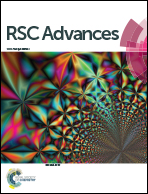Optimizing PVD conditions for electrochemical anodization growth of well-adherent Ta2O5 nanotubes on Ti–6Al–4V alloy†
Abstract
Well-adherent tantalum pentoxide nanotubes (Ta2O5 NTs) were successfully grown on Ti–6Al–4V alloy (Ti64) through optimization of physical vapor deposition magnetron sputtering (PVDMS) followed by a two-step anodization and subsequent thermal treatment from 450 to 1000 °C for 1 h with a heating/cooling rate of 1 °C min−1, under atmospheric conditions. The effective sputter yield during the magnetron sputtering process was achieved with a DC power of 350 W, temperature of 250 °C and a deposition time of 6 h. The results showed that the anodization time played a key role in the growth of the Ta2O5 NTs and microstructural evolution. The nanotubes pore size and tube length varied from 18 to 30 nm and 73 nm to ∼4 μm as anodizing time rose from 30 s to 20 min, respectively. For the 450 °C annealed sample with the strongest adhesion, the scratch length, failure point and adhesion strength were 1024 μm, 863 μm and 2301 mN, respectively. The 450 °C annealed coating showed the highest wettability (lowest contact angle value) among the specimens. This multi-step approach could be considered for the design of various nanostructured titanium implant surfaces.



 Please wait while we load your content...
Please wait while we load your content...